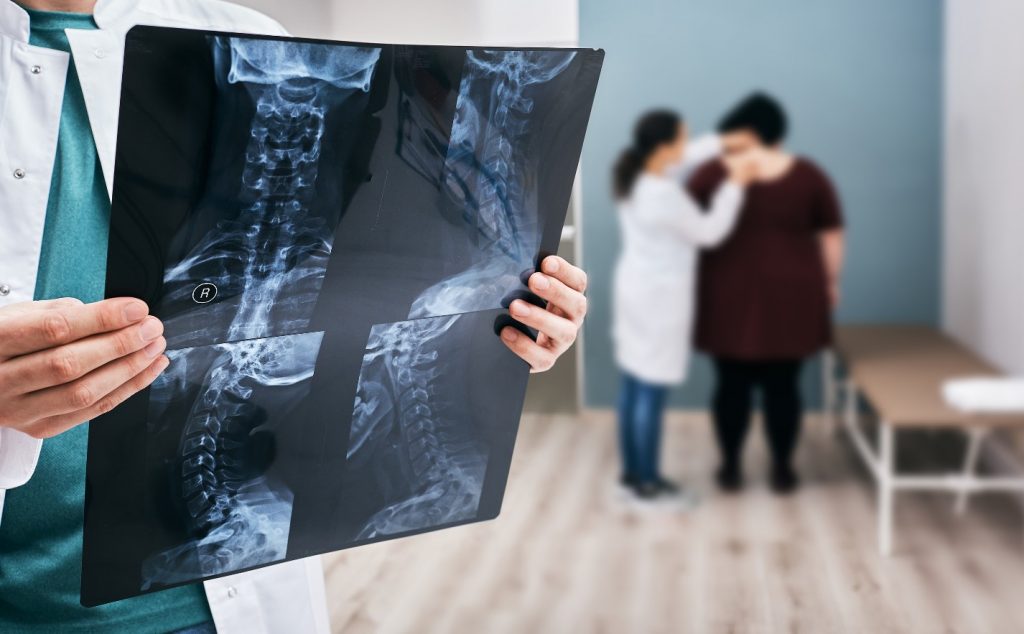Even in today’s modern world, with our state-of-the-art medical treatment, one injury still often eludes successful treatment – spinal injuries. Moderate damage to the vertebrae in the neck and back can lead to total paralysis and a lifetime of pain.
Cervical Spine Injuries
The spine consists of approximately 29 separate vertebrae running from the neck to the pelvic area. Traditionally, the spine is divided into the cervical, thoracic, lumbar, and sacral regions
The seven cervical vertebrae are nearest the brain and are numbered C1 through C7. Since they are closer to the brain and control more of the body, injuries to these vertebrae and nerves are often the most serious. Damage in this area can result in quadriplegia, or else the partial lack of feeling or movement below the neck. Even if a victim isn’t totally or partially paralyzed, there are a host of other complications that can arise from injuries to the cervical spine.
Upper Cervical Spine Injuries
Damage to the C1 through C4 region may result in:
- Paralysis in arms and legs
- Inability to breathe without mechanical assistance
- Loss of bladder control or bowel movements
- Reduced ability to speak.
The victim may need around-the-clock personal care.
Middle Cervical Spine
Injuries to the C5 and C6 vertebrae and associated nerves may cause:
- Inability to move arms or bend elbows or possible paralysis of any extremities
- Weakened ability to speak and breathe
- Partial or total loss of control of bladder or bowel movements.
The patient may need help with most daily activities.
Lower Cervical Spine
A person with C7 injuries may have difficulty controlling hand movement and little or even complete loss of control of bladder or bowel movements.
Diagnosis of Cervical Spine Injuries
Physicians perform a range of diagnostic tests to assess the severity of a cervical spine injury. These include measuring the patient’s strength and feeling in their hands, arms, and legs. Doctors also use imaging tools like X-rays and MRIs to detect vertebrae fractures, pinched nerves, and other abnormalities.
Recovery from Spinal Injuries
The hard truth is that severe injuries to the cervical spine can cause permanent damage, and in some cases, quadriplegia. For others, physical therapy and surgery may be successful in restoring some or all of the body’s functions.
Case Studies
Injuries to the cervical spine are not theoretical. They happen every day and have a devastating impact on the victim. Below are three case studies in which OAS played a pivotal role in securing damages.
1. Dump Truck Crash
A dump truck loaded with rocks came barreling down a hill and crashed into a car that was stopped at a red light. In a chain reaction, that car smashed into a vehicle driven by a New Jersey man. This victim suffered injuries to the cervical spine that became worse with time.
He underwent multiple surgeries and spinal fusions but was unable to continue his work as a mail carrier. The defendants argued that his injuries were the result of a pre-existing condition. However, the vocational experts from OAS were able to examine the plaintiff’s injuries and offer an objective assessment. This helped lead to a $750,000 settlement.
2. Construction Accident
A 30-year-old ironworker claimed he was injured at a construction site where a new building was being constructed. He said he was working on a canopy when he fell approximately 25 feet to the ground.
The worker suffered severe injuries throughout his body, including to the cervical spine. Specifically, he had bulging discs at C2 to C7, with extruded disc material at C3 to C4. Working in conjunction with the plaintiff’s attorney, OAS prepared extensive medical models of the spinal injuries. The case resulted in a verdict of $3.9 million.
3. Car Accident
A 38-year-old landscaper was a passenger in a car driven by the defendant. They were traveling down a road when the defendant lost control of the vehicle and it crashed into a tree and utility pole.
The plaintiff landscaper suffered severe cervical spine injuries, including a fracture dislocation at C2-C3 and eventual spinal fusion at C1, C2, and C3. Plaintiff claimed he had a restricted range of motion in his neck and testified that he could not perform sedentary work.








